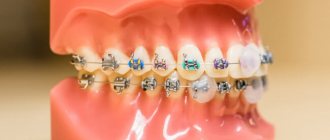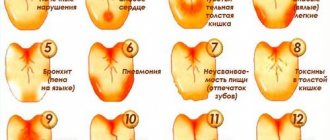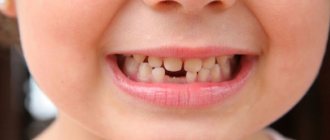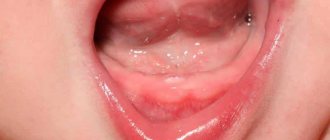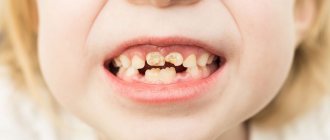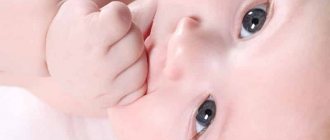First tooth how and when
According to the rules, the first milk tooth grows by 6-8 months of age. Often the two upper front teeth erupt simultaneously, followed by the lower ones, also in the amount of two. In one year, babies can have 8 or more teeth, but this does not always happen.
Not all children develop the same way. It is not at all necessary that their development correspond to any accepted norms or standards.
Normally, the first baby tooth grows by 6-8 months of age.
Some children may have teeth as early as 4-5 months of age, especially those who are bottle-fed, while breastfed children may have them by 12 months. There are many reasons for this, including, in particular, the child’s genetic predisposition and nutrition. For example, milk formulas and cereals contain a sufficient amount of minerals and vitamins, as well as a complex of other vital elements for development, which significantly affects the growth of teeth. When teeth erupt at 12 or more months, there is no need to sound the alarm, according to experts.
Doctors say that it is quite normal for teeth to appear at 1.5 - 2 years . In boys, development occurs more slowly than in girls, which is reflected in the later appearance of the first teeth. Modern medicine has long refuted the idea that delayed tooth growth is associated with childhood rickets. Currently, there are many children with normal development whose teeth appear at an older age.
Therefore, you can remain calm about this for a longer time, but you should pay attention to some signs, and it is advisable to consult a pediatrician and dentist.
Norms for the eruption of first teeth
According to existing standards, a child’s first teeth should appear at 5-6 months. But these indicators do not mean that being somewhat ahead of schedule or behind it is a serious deviation, because each organism is individual. Therefore, answering the question why a child has no teeth by 7 months, we can say with confidence that this is a variant of the norm, this is how it develops. You only need to worry if by 10 months the first teeth have not made themselves known. In such cases, doctors prescribe vitamins for the baby.
At the same time, differences between children in the timing of teething may also arise due to the type of feeding they receive. Thus, in children who eat breast milk, teething is often quite long and painful. But the majority of artificial babies can boast of incisors by the age of 5 months. This feature is explained by the presence of large quantities of minerals and vitamins in cereals and mixtures.
Sometimes the answer to the question of why a child has no teeth by 7 months is very simple. After all, many people expect the appearance of the lower incisors first. But in some cases, their appearance can be preceded by the upper canine, which parents, of course, do not immediately notice. This is also one of the normal options, and not an alarming signal, so there is nothing to worry about. It happens that this order of teeth appearance is due to heredity.
Sometimes after the appearance of the first tooth there is a long break - the next tooth does not always appear in a couple of days or a week. Although in most cases paired eruption is observed.
One way or another, this is a rather painful process, so it would be a good idea to use special gum-cooling gels and liquid-filled teethers. Sometimes the appearance of teeth is accompanied by a runny nose and fever.
If a child has no teeth at 7 months
To get rid of worries and worries that the baby has no teeth at 7 months, parents can help by contacting a pediatric dentist, who will offer to take a panoramic x-ray. The image will reflect the presence of tooth buds in the child's jaw. Embryonic disorders include adentia, characterized by the absence of teeth (complete or partial).
Panoramic x-ray of the jaw with baby teeth
The phenomenon is extremely rare and is transmitted mainly by inheritance. If a specialist discovers rickets in a child, then the usual lifestyle of the baby and mother will have to be changed. Treatment of the disease involves a set of measures, such as:
- a diet in which it is recommended to introduce foods such as vegetable puree starting from 6 months, egg yolk from 7 months, and limiting the intake of flour;
- taking medications prescribed by a doctor, such as calcium, vitamin D, phosphorus;
- massage treatments;
- walks in the fresh air daily;
- swimming in the pool and so on.
Parents who have experience with the problem of the appearance of the first teeth recommend using several tips to help your baby grow strong teeth:
- Give curd products up to 50 grams. in the daily diet starting from 8 months;
- in addition to calcium supplements, some parents give natural chalk to chew;
- eat grated vegetables, fruits such as carrots, apples and others;
- eat softened food, a variety of purees;
- vitamins, minerals in combination, such as preparations calcid, vitrumkidz and similar ones;
- some dentists suggest using gels to soften the gums of babies, facilitate teething, or cut the gums if there are serious indications;
Some grandmothers and mothers, concerned about the lack of teeth in their baby, undertake such barbaric methods as tearing and excision of the gums on their own. This is strictly prohibited by doctors, since gum injury is possible and there is a high risk of wound infection.
Also, you should not give refined sugar cubes for teething. Children under 3 years of age should not be given sweet foods, as they interfere with the absorption of vitamin B, calcium and disrupt the functioning of the intestinal and stomach systems.
Hourly anxiety, when a child still has no teeth at 11 months, should be excluded. Many worried relatives should understand and remember that each person is individual. And it is unlikely that you will be able to achieve ideal perfection in your diet, development and growth of teeth.
9 month old baby has no teeth
Often parents eagerly await the appearance of their baby's first tooth, but it still doesn't come through. The known norms for the timing of the eruption of the first teeth are from 4 to 7 months of life. And if time passes and the child has no teeth at 9 months, many mothers begin to panic. They worry whether everything is normal with the development of the baby’s body, whether he has any disease. Let's consider how many teeth a child should have at 9 months, according to the norm, and why sometimes teeth appear later.
There are established dates for the eruption of the first teeth, which pediatricians focus on in order to monitor the overall development of the child. But parents should understand that all such standards are approximate. Some babies are born with teeth, while others may have their first tooth at 15-16 months.
If parents are wondering how many teeth a child should have at 9 months, they can use a special formula. This formula is very simple, and with its help you can determine the number of teeth in children under two years of age.
K = M – 4, where K is the number of teeth, M is the number of months of the baby’s life.
According to this formula, the number of teeth a child has at 9 months is: 9 – 4 = 5.
Typically, at the age of nine months, the baby has upper and lower front incisors and one upper, and sometimes lower, lateral incisor.
If your baby has not yet developed teeth at 9 months, there is no need to worry. Dentists consider it quite natural for children to experience delayed tooth growth at 5-6 months. Typically, girls erupt their first teeth earlier; boys wait longer for their first tooth.
The timing of the first tooth eruption is influenced by many factors. We can identify the main reasons why a baby has no teeth at 9 months:
- Hereditary predisposition. Parents should know that if their teeth came out late, then they shouldn’t expect their baby’s teeth to appear early. This is especially true for heredity on the mother’s side.
- Diseases of the mother during pregnancy. Some diseases of a pregnant woman during the formation of tooth germs can provoke a delay in the eruption of the first teeth. Tooth buds are formed at 6 weeks of pregnancy, and at 14 weeks, hard tooth tissue begins to form. Infectious diseases of women are especially dangerous during this period of pregnancy.
- Unhealthy lifestyle of the expectant mother. Doctors point to the harmful effects of alcohol, nicotine and drugs on the eruption and growth of teeth in a baby.
- Illnesses of a child in the first month of life. During this time, tooth enamel and dentin are formed, and some diseases can cause slow tooth growth. Such pathologies include intestinal and stomach diseases, rubella, and congenital syphilis.
- The development of rickets is a disease that is caused by calcium deficiency in the body. It is characterized by impaired bone formation and insufficient mineralization.
- Lack of vitamins and microelements. A deficiency of vitamins (especially vitamins D, A, E, B) and micro- and macroelements, in particular calcium and fluoride, can cause delayed dental growth.
- Individual characteristics of the baby's development. Each human body is unique and can develop according to its own timing, which differs slightly from the generally accepted ones.
Often mothers worry whether the fact that the baby has no teeth at 9 months is due to the development of adentia - a disease in which the rudiments of teeth are absent. But at this age it is still impossible to talk about this pathology. You need to wait a few more months, and if the tooth does not appear, you can show the child to the doctor. The presence of tooth buds is checked using x-rays.
source
Usually, at 5-6 months, babies have their first teeth. However, in some children the growth of milk units is delayed. Many mothers, if their child is already 9 months old and still has no teeth, begin to worry. What is the reason for missing teeth at this age? Is it pathological? What should parents do? The article will answer these questions.
According to medical standards, the baby's first teeth erupt at about 5-6 months. The lower central incisors appear first, and a little later (at 7-12 months) the upper central incisors appear.
Next in line are the lower lateral incisors, followed by their upper counterparts. They usually erupt between the ages of 8 and 16 months. After a year, the first molars appear - with the lower ones erupting before the upper ones. Second molars appear at approximately 2 years of age. From below - at 20-32 months, and from above - at 2-3 years.
Fangs break through the gums from 1.5 to 2 years. The upper teeth begin to grow a month earlier than the lower ones. However, in some children this order is disrupted: all canines appear at once, or the lower ones erupt before the upper ones.
A set of 20 teeth remains until 5-7 years. Next, the milk units gradually fall out and permanent teeth grow in their place.
Many mothers and fathers track the number of teeth according to the child’s age using a special formula. It has the following form: Kz = Mf - 4, where Kz is the number of milk units that have erupted, and Mf is the baby’s age in months.
Based on this formula, at 9 months the child should have 5 milk units. However, sometimes during this period the baby does not yet have a single tooth. Why is this happening? What are the reasons for deviation from the general norm?
Modern doctors note that children have recently developed rapidly in the intellectual sphere. However, with an accelerated rate of mental development, some children experience a delay in physical processes, which include tooth growth. In addition, the following reasons for deviations from the average timing of teething are identified:
- Heredity. Children, at the moment of conception, receive part of their parents' genes. If the mother or father has experienced a delay in the eruption of baby teeth, then the likelihood that the baby’s teeth will appear late also increases.
- Ecology. Under unfavorable environmental conditions, some processes in the child’s body slow down and teeth begin to erupt quite late.
- The process of gestation. The rudiments of teeth begin to form in the middle of the first trimester of pregnancy, and at the beginning of the second, dental tissues are already formed. If during this period the expectant mother was ill or took medication, this may affect the growth of teeth.
- If a woman drank alcohol or smoked during pregnancy, then the child’s physiological processes are inhibited after birth.
- Nutrition. Lack of vitamins and microelements also affects the timing of teething. Not only the nutrition of the baby itself is important, but also the nutrition of the mother during pregnancy and during breastfeeding. To ensure that the baby does not have problems with teeth, the expectant mother needs to eat properly and take multivitamin complexes prescribed to her by the doctor.
- Early refusal of natural feeding. Doctors have identified a pattern between the development of children and the principles of their nutrition in the first months of life. Tooth growth is delayed in those infants who were fed with adapted formulas rather than breast milk.
- Congenital or acquired diseases of the baby. Many infants who have suffered a serious illness in the first year of life are delayed in physical development.
- Rickets. This disease occurs due to a lack or improper absorption of calcium. When the disease occurs in children, the strength of bone tissue is impaired.
- Gender. According to statistical studies, girls develop teeth earlier than boys.
- Maturity of parents. As a rule, children of mature mothers and fathers become “toothy” earlier than their peers whose parents are very young.
- Dates of birth. Premature babies erupt teeth later than babies born after 9 months of pregnancy.
- Developmental anomalies. Some people have congenital adentia. This pathology is expressed in the absence of tooth buds. However, it is very rare.
Dr. Komarovsky draws the attention of parents to the fact that each child develops individually. The doctor, like many other specialists, believes that a delay in tooth growth even for 6 months is not a sign of pathology.
Parents do not need to panic if the baby has no teeth at 9 or even 10 months. Komarovsky advises parents not to look for a way to speed up the process of tooth growth in a child, since it does not exist. Pediatricians and dentists cannot make teeth grow faster.
However, if a child has no teeth at one year, then it is necessary to show him to a dentist and pediatrician. Doctors examine the baby to rule out edentia and rickets. If these diseases are detected, specialists will decide what to do next. For rickets, vitamins, massage and physiotherapy are prescribed.
As for congenital adentia, it cannot be cured. If an anomaly is detected, children, upon reaching the age of three, are given removable dentures. As the child grows, the structure is continually adjusted to accommodate jaw growth. At the age of 16-18 years, a teenager diagnosed with edentia can have implants inserted.
If a child has no teeth at 8 months
If at 8 months everything is fine with the child’s health, but there are no teeth, then you should just wait
Infants up to one year old are regularly examined by a pediatrician, neurologist and other specialists for the presence of various diseases. And if the question arises when there are no teeth at 8 months, the reasons may be as follows:
- hereditary, individual characteristics of the body;
- rickets, which is associated with a lack of calcium, which affects the formation of bone tissue. The disease prevents the eruption of baby teeth;
- lack of minerals, vitamins such as B, D, fluorine and other elements;
- the pathological phenomenon of complete or partial absence of baby tooth buds, which is associated with a disturbance during intrauterine development. This also affects the retardation of hair and nail growth.
Read also: Diagram of the appearance of teeth in infants
If the listed factors are absent in the baby, and doctors have not identified other pathologies, the only correct decision will be to wait calmly without worry. In any case, the teeth will begin to grow, and the child will feel normal . For greater peace of mind, you can repeat the panoramic x-ray procedures at the dentist, which is absolutely harmless for children and adults. It is advisable to do it after 12 months.
Pediatricians and dentists can also prescribe a certain complex of vitamins and recommend the consumption of vegetables and fruits in the diet. You can independently give your babies rubber teethers, which promote the accelerated appearance of rudiments on the surface of the gums.
What to do?
It is worth assessing the situation with the help of a pediatrician and dentist. If doctors note a clear violation of eruption or retention, treatment will be prescribed in accordance with the identified disease.
The baby will have to undergo a number of examinations, have his blood tested and have his gums x-rayed. Parents will have to remember all relatives and their illnesses to compile an anamnesis.
But you should also pay attention to the baby’s diet. Does he get enough vitamins and minerals? Do you spend a lot of time outdoors? It is no secret that vitamin D enters the body when the skin is exposed to ultraviolet radiation. It is also contained in products, but in small quantities.
A toddler should already be receiving complementary foods at 8 months. At this age, the diet includes porridge, vegetables and cottage cheese. On the recommendation of a pediatrician, you can give your baby vitamin therapy.
Number of teeth at the age of 9 – 11 months
If your child has no teeth by 10 months, you should consult a doctor.
From eight to nine months, many babies begin to move independently on all fours, sit confidently, stand on their feet without the help of adults, and even dance.
They also chew food and bite off certain foods on their own. Some of them have more than six teeth, while others erupt two upper incisors while already having two lower ones. But when the child is 9 months old and has no teeth, you should not worry too much if he is examined by doctors and everything is fine. Teeth develop long before the baby is born, but the first teeth can erupt at the age of 11-12 months and much later.
If there are no pathological phenomena in development, and the child is 10 months old, but has no teeth, you can wait in any case or also consult a doctor.
In addition to the diseases and abnormalities listed above, the late appearance of teeth may be affected by:
- densely spaced teeth in the gums;
- diseases of the endocrine system, such as hypothyroidism, which results in decreased activity of the endocrine glands;
- previous chronic diseases.
The pediatric dentist can prescribe a biochemical blood test for the baby with an examination of the thyroid gland, as well as conduct an ultrasound examination. Based on the results obtained, the doctor prescribes the necessary course of treatment. It is likely that with normal development, as mentioned above, it can also be that at 11 months there are no teeth at 2 years.
The appearance of teeth and their signs in a child
The main signs when a baby’s teeth appear include the following:
- excessive secretion of saliva , causing irritation in the chin and mouth;
- The baby's gums itch , he puts almost everything in his mouth that is at hand. For this case, purchase a specially designed rubber ring from the pharmacy;
- inflammation and swelling of the gums with pain, the baby is often nervous, does not sleep, and there is increased tearfulness. Also, teething is accompanied by frustration, loose stools, and fever;
Baby's first teeth
When teething, the gums may become swollen with a bluish color, which is considered normal. Over time, hematoma formations will disappear on their own, but the pain sometimes spreads to the ears and cheeks. To relieve pain, you can give teething rings chilled in the refrigerator.
You can also give your mother a finger massage on the gums to relieve pain with a finger wrapped in a sterile bandage. The child is also given a piece of carrot and hard bread. Painful symptoms are eliminated with special ointments that are applied to the child’s gums.
Signs of the appearance of the first teeth
The process of the baby’s first teeth appearing in most cases has a number of distinctive features and is accompanied by many symptoms.
1. An increase in temperature can be observed from 1 to 3 days. In some babies, this phenomenon accompanies the teething process for up to five days. The thermometer can reach 39 degrees. To reduce body temperature, pediatricians prescribe various antipyretics to the baby.
2. Malaise and weakness can also accompany an important process. As a rule, this phenomenon is caused by an increase in temperature, as well as discomfort in the gum area.
3. Poor appetite is explained by the presence of painful sensations in the gums. During teething, doctors recommend giving your baby as much liquid and food of a similar consistency as possible.
4. Sleep disturbance.
5. Increased salivation.
6. Cough, runny nose. Cough is a consequence of increased salivation.
7. A constant desire to chew on various objects and suck a finger. During the period of teething, a small child practically does not remove his hands from the oral cavity.
It is very easy to confuse the above symptoms with signs of an incipient viral disease or cold. That is why it is very important to immediately consult a doctor if one of the symptoms is detected (especially if the temperature rises). The pediatrician will determine the true cause of the illness and prescribe treatment. Self-medication is strictly prohibited. This may harm the baby's health.
Prevention of teething disorders
Experts advise many women who are planning a pregnancy to prepare for this condition systematically. To do this, the expectant mother needs to treat her own teeth, take vitamin complexes, and eat foods rich in calcium.
It is advisable to be outdoors more often and monitor the level of hemoglobin in the blood. You should get rid of bad habits such as smoking, alcohol and not take medications on your own that were not prescribed by a specialist. After the birth of a child, it is important to monitor the baby’s adequate nutrition, often walk in the fresh air, carry out hardening procedures and carry out regular hygiene. It is important to pay attention to the baby’s immunity, which during colds can create problems with development, including teething.
What to do if a child has no teeth at 7 months
In pediatrics, it is considered normal if a child has his first central incisors before the age of six months, but what if there are no teeth at 7 months? To exclude a disease or identify a predisposition to it, the development and health of the baby is monitored by a pediatrician who examines him 1-2 times a month, as well as a neurologist, orthopedist, and ENT specialist. The dentist sees the baby for the first time at 9 months. He determines the correct formation of teeth that have not yet erupted and the formation of the bite, and gives recommendations for oral care. Even if the baby does not yet have a single tooth, a mother with a 9-10 month old child should go to the pediatric dentist.
If your health is fine
The timing of eruption depends on heredity, including grandparents, and on external factors. It is believed that in hot climates, teeth appear earlier, as early as 4 months. When a child is healthy and his development corresponds to his age, but there are still no teeth, although they should already appear in accordance with average standards, this causes concern among parents. Modern doctors indicate only approximate dates for the sequence of growth of the first teeth. The standard teething pattern looks like this: from 5–6 months - on each jaw there are 2 central incisors (first from below, then from above), from 8 months - lateral incisors, by the year the child has only 8 teeth. They are known to appear in pairs and alternately on both sides.
What to do if a child has only grown one tooth and there are no signs of a second one? You need to know that the sequence of teething may be different and this is not considered an anomaly. There are many options for their appearance. At seven months they can erupt 2 - from below, then 1 - from above, then the third and fourth - in the bottom row, and only after them the missing top one.
Many mothers tend to associate the whims of a 3-4 month old child, poor sleep or appetite with the imminent appearance of the first incisors. There is no doubt left if the baby also puts everything into his mouth and drools profusely. Sometimes it seems to mothers that the gums are already red; they look into the child’s mouth in the hope of seeing that swollen white ball from which the long-awaited tooth is about to emerge. But days and weeks pass, the child is already 7 months old, and there are no teeth? No need to panic.
If the baby’s health is fine, you just need to wait, especially since all the dates are individual and there may be deviations in one direction or another for six months. Some children have their first incisors at 4 months, while other babies can already walk by the time they begin to emerge.
Why don't teeth grow?
The timing of the appearance of incisors is influenced by diseases, especially infectious diseases suffered in the first 28 days of life after birth, nutrition, and the quality of drinking water. It is important how the pregnancy proceeded and the lifestyle of the expectant mother. If she had a calcium deficiency, this will affect the fetus and may further cause delayed growth of the child’s incisors.
The first signs of the beginning of tooth development are noticeable at 6–7 weeks of the embryo’s life; gradually 10 enamel organs appear on each jaw. After 13 weeks, the formation and separation of the primordia of baby teeth occurs in the fetus. Directly above them, at week 23, permanent rudiments form. If during the process of laying the germs of teeth the fetus is exposed to unfavorable factors, then hypodontia or adentia may develop - a pathology in which the child lacks the rudiments of milk teeth: one, several or all, which is extremely rare. Doctors associate this anomaly with general and specific toxic diseases, follicle resorption, endocrine disorders and heredity.
Examination and treatment
If a child has no teeth at 10–12 months, the pediatrician may prescribe an examination to determine the reasons for the delay. A panoramic x-ray shows whether there are baby tooth buds in the child's jaw. In case of partial edentia, specific treatment is prescribed to allow the embryos of permanent teeth to develop correctly. To ensure that the jaw is formed correctly and food is chewed efficiently, special removable dentures are made to compensate for missing baby teeth for a 3-year-old child.
The doctor may prescribe an ultrasound scan of the abdominal organs, blood tests, stool tests, urine tests of the child and others, if necessary. Vitamins and minerals are prescribed to strengthen the immune system, primarily vitamin D and calcium. The child should spend as much time as possible outdoors. He is given ring toys as a stimulant. A light massage of the gums with a clean finger is helpful.
Parents should be alerted if the incisors erupt too early, before 3 months. In some cases, this may indicate disorders in the endocrine system, but more often than not, early teething in children is an individual feature.
Before appearing from the outside, the incisor passes through the bone tissue surrounding it, and then through the mucous membrane of the gums. Do I need help with teething? Trying to speed up the process of its appearance with a piece of sugar, a spoon or other objects, you can damage the gums and introduce an infection into it.
According to a good ancient tradition, the one who discovers the child’s first tooth gives him a silver spoon. It is believed that she will bring him health and wealth. She can lightly tap the tooth and make sure that it has erupted and all anxious expectations are left behind.
How to help your baby
If a child has no teeth at 8 months, Komarovsky, a children's doctor whose opinion is listened to by millions of mothers and fathers, recommends not to fall into despair. In his opinion, the task of parents is to help their baby survive the difficult period of teething. It is important for new mothers and fathers to give their baby as much fluid as possible. The most suitable drinks would be fruit drinks and compote, which will not only perfectly quench the child’s thirst, but will also help strengthen the body’s defenses. After all, during teething, the immune system is very vulnerable.
To distract the baby, parents need to play fun, but not too tiring games with him, and also spend more time outdoors. To reduce itching, you can give your baby solid vegetables or fruits or use a special teether, which can be purchased at any pharmacy and baby goods stores.
Baby has no teeth at 7 months: worry already?
No matter how old a child is, for parents his health will always be the most important and the baby’s first tooth that appears will be a holiday for them. For this reason, they eagerly wait for him to show up. When a child is 6 months old and has no teeth, many begin to sound the alarm. Although there is no reason for this yet, because according to the formula: “M – 6 = K”, where “M” is the age of the baby, and “K” shows how many of them should have erupted by this moment, and from this it turns out that panic was unnecessary.
Unfortunately, many parents do not know what to do when a child at 8 months has no teeth and fear the worst, so they strive to find out whether this is some kind of serious illness or just given by nature.
The norm of the appearance of the first teeth
Usually, parents begin to look into the baby's mouth in search of the long-awaited tooth when he is 6 months old. Many of them soon find what they are looking for there. The rest patiently continue to carry out daily inspections. When a child turns 7 months old and still has no teeth, this is not a reason to worry. Most parents know this and therefore remain calm.
But when a baby doesn’t have a single tooth at 8 months, there is slight anxiety in the family. After all, everyone knows that from six to the beginning of the ninth month the incisor should appear. But should you? In fact, these norms are based on average statistics and are not a rule. There are cases when children are already born with several teeth, and it happens that the baby’s first incisor pecks only in the 9th or even 12th month of his extrauterine life.
Additional Information. In general, pediatricians advise parents not to panic if a long-awaited event drags on for up to 1.5 or even 2 years. Of course, provided that the rest of the baby develops normally.
Dates of appearance
According to generally accepted standards, the first tooth usually erupts in the lower jaw and this occurs at 6-8 months. There have been cases when it grows on the upper jaw and there is nothing wrong with that. This is often due to heredity. By the age of one year, children should already have 4 incisors on both jaws.
Timing of appearance of baby teeth
It is worth noting that the timing of the appearance of each baby is individual and therefore if a child does not have milk teeth at 7 months, this is not a pathology and there is no need to worry.
Often the timing of the appearance of teeth depends on how the baby was fed. In those who were fed naturally, they appear later and the process itself is longer. As for children who were fed formulas, their teeth erupt earlier and the process itself goes faster. This is explained by the fact that the adapted milk composition has more vitamins and microelements necessary for a young body. Therefore, it is quite normal that when breastfeeding at 9 months the child has no teeth, but with artificial ones they can begin to appear from 4–5 months.
Reasons for slowing down the process
When the baby is at such an early age, you need to be patient and wait, and you don’t even have to think about why a child at 8 months does not have milk teeth and what to do about it, but give his body a little more time.
Teeth cutting
Many experts agree that a delay in the appearance of the first teeth of up to 6 months is quite normal. Thus, you don’t have to worry about the baby’s health for up to a year, but if by 8–10 months there are no signs of teething, then you can consult your pediatrician, as well as your dentist.
First of all, the pediatrician will need to conduct a comprehensive examination to rule out the presence of disorders or disease. Reasons why a child’s teeth do not grow well include:
- Metabolic disorders of the child;
- Diseases caused by infections;
- Insufficient amount of vitamin D;
- Improper bowel function.
The dentist will examine your mouth and send you for an x-ray, which will show you when you can expect the teething process to begin. This is mainly done to reassure parents, because there is no special need for a photo if their child is not yet a year old. The exception is illnesses during pregnancy in the mother.
If no pathologies were found, then the dentist will have a conversation and explain to the parents why their child’s teeth are growing slowly or not at all, and may also prescribe a complex of vitamins to make the process go faster.
The child is 8 months old, but has no teeth: the main reason
As it turned out, there may be several reasons for the fact that a child has no teeth at the age of 8 months. Even if other children of this age have at least a pair of incisors, parents of a “toothless” child should not stress themselves out. If the baby has developed some kind of pathological abnormality or deficiency of substances, the pediatrician probably noticed this during the examination. Few children's health problems are manifested by a single symptom. Edentia is extremely rare. So there is no reason to be particularly worried.
Hence the conclusion: the delay in the eruption of baby teeth is either a distinctive feature of the baby, or is caused by the hardness of the gums. Having found out for themselves why a child has no teeth at 8 months , parents always want to understand what to do about it. The answer is simple: in the first case, wait, in the second, use products that soften the gums or let him chew hard foods.
Read also: Teething of upper teeth in infants
Problems during tooth change
During childhood, a baby develops 20 baby teeth, which will eventually fall out and molars will appear in their place. They begin to fall out at about 6–7 years of age and this process ends at 12–13. In turn, 8 teeth will immediately grow molars during the same period. As for the last 4 molars, they grow from 16 to 25 years of age, but in some people they never appear.
Sources:
https://vashyzuby.ru/detskie-zubki/pochemu-u-rebenka-net-zubov-v-7-8-9-10-mesyacev.html https://zubi.pro/detskaya/net-zubov-v -7-mesyatsev.html https://izubki.ru/detskaya-stomatologiya/u-rebenka-ne-rastut-zuby.html
Period of eruption of molars
Of a baby's 20 baby teeth, the last 8 to erupt are molars, meant for chewing. They are also called indigenous. They usually begin to appear in children after one year.
Note! Contrary to popular belief, molars are not those that replace milk teeth, but those that are used for chewing food. Dairy ones are replaced by permanent ones. The reasons why a child’s molars do not grow for a long time are the same as in the case of other teeth.
Typically, molars in children appear like this:
- 12 and 13 months the first four appear;
- from 20 to 24 months the baby acquires the last four.
It turns out that by the age of two, the baby should already have a full set of baby teeth. But this so-called “standard” scheme is very approximate. All children are individual and develop in their own way.

